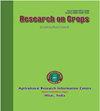评价新除草剂对伊拉克中部小麦(Triticum aestivum L.)性能的影响
Q3 Agricultural and Biological Sciences
引用次数: 0
摘要
由于杂草对作物造成的巨大损失,有必要继续测试新的除草剂,这种除草剂可能比使用的除草剂更有效,可以减少杂草与作物之间的竞争。因此,在农业工程科学学院作物系的试验田进行了田间试验,巴格达大学(Al-Jadriya)在2021-22年冬季,以评估除草剂H-199的效率,并将其与用于控制三个小麦品种的伴生杂草的一些除草剂及其对产量及其成分的影响进行比较。该实验根据随机完全区组设计进行,采用四个重复的分裂地块排列,因为品种(IPA 99、Sham 6和Rasheed)代表主地块,而除草剂(H-199、Chevalier、Pallas、Atlantis和杂草处理)代表子地块。结果表明,Pallas的优势在于,与对照处理相比,施用除草剂30、60和90天后,其杂草密度最低,分别为0.2、4.3和0.2株/m2,杂草控制率最高,达到99.85%,杂草密度最高(116.3171.0和168.7株/m2),杂草控制率最低(0.00%),这反映在产量构成中。与穗数最低(122.7穗/m2)、穗粒数最低(33.87粒/穗)、,产量最低(0.937t/ha),收获指数最低(19.69%)。此外,与杂草处理相比,Atlantis的1000粒重最高,为26.35g。结果还表明,Sham 6的杂草密度最低,穗数最多,1000粒重最高,产量最高,收获指数最高。我们得出的结论是,Pallas和Sham 6(品种)记录了最好的结果。本文章由计算机程序翻译,如有差异,请以英文原文为准。
Evaluating newer herbicides on the performance of wheat (Triticum aestivum L.) in Central Iraq
Due to the great losses caused by weeds to the crop, it is necessary to continue testing new herbicides that may be more efficient than the herbicides used that can reduce competition between weeds and crops, Therefore, a field experiment was carried out in the experimental field of the Department of Field Crops, College of Agricultural Engineering Sciences, University of Baghdad (Al-Jadriya) during the winter season of 2021-22 in order to evaluate the efficiency of the herbicide H-199 and compare it with some herbicides used in controlling companion weed to three cultivars of wheat and its effect in the yield and its components. The experiment was applied according to the randomized complete block design with split-plot arrangement with four replicates, as the cultivars (IPA 99, Sham 6 and Rasheed) represented the main plots, while the herbicides (H-199, Chevalier, Pallas, Atlantis, and weedy treatment) represented the sub-plots. The results showed the superiority of Pallas by giving the best results, it gave the lowest weed density after 30, 60 and 90 days of application the herbicide, which amounted to 0.2, 4.3 and 0.2 plants/m2, respectively, and the highest weed control percentage amounted to 99.85%, compared with the control treatment, which gave the highest weed density (116.3, 171.0 and 168.7 plants/m2) and the lowest weed control percentage (0.00%), which was reflected in the yield components. Pallas gave the highest number of spikes, the highest number of grains per spike, the highest grain yield, and the highest harvest index, which reached 314.6 spikes/m2, 55.99 grains/spike, 4.597 t/ha and 32.08%, respectively, compared with the weedy that gave the lowest number of spikes (122.7 spikes/m2), the lowest number of grains per spike (33.87 grains/spike), the lowest grain yield (0.937 t/ha) and the lowest harvest index (19.69%). Moreover, Atlantis gave the highest weight of 1000 grains, which was 26.35 g, compared with the weedy treatment. which gave the lowest weight of 1000 grains (22.80 g), The results also showed the superiority of the Sham 6 cultivar, as it gave the lowest weed density, the highest number of spikes, the highest weight of 1000 grains, the highest grain yield and the highest harvest index. We conclude that Pallas and Sham 6 (cultivar) recorded the best results.
求助全文
通过发布文献求助,成功后即可免费获取论文全文。
去求助
来源期刊

Research on Crops
Agricultural and Biological Sciences-Soil Science
CiteScore
1.50
自引率
0.00%
发文量
93
审稿时长
1 months
期刊介绍:
The Research on Crops is a peer-reviewed journal publishing original research papers, review articles and short communications in English on all basic and applied aspects of crop sciences, agricultural water management, agro-climatology, agroforestry, agronomy, crop production, crop protection, cropping systems, food science & technology, genetics & plant breeding, horticulture, plant & soil science, plant biotechnology, plant nutrition, post-harvest management of crops, seed science, soil management & tillage, vegetables, weed science, agricultural engineering, agri-business, agricultural economics and extension, etc. The aim of the journal is to provide a forum for the scientific community to publish their latest research findings.
The manuscripts submitted for publication should not contain data older than 4 years on the date of submission.
The articles submitted for publication in this journal should not be submitted elsewhere simultaneously for publication in another journal. These should not carry any copyright material without prior permission of copyright holder.
The articles should present a complete picture of the investigation made and should not be split into parts.
There is no prescribed limit regarding the number of pages in case of full-length articles. However, the authors are advised to keep the length of their articles from 4 to 10 full printed pages of the journal.
The articles should be divided into the sub-sections: ABSTRACT, INTRODUCTION, MATERIALS AND METHODS, RESULTS AND DISCUSSION, CONCLUSIONS, and REFERENCES. Tables and figures should be appended separately at the end.
 求助内容:
求助内容: 应助结果提醒方式:
应助结果提醒方式:


